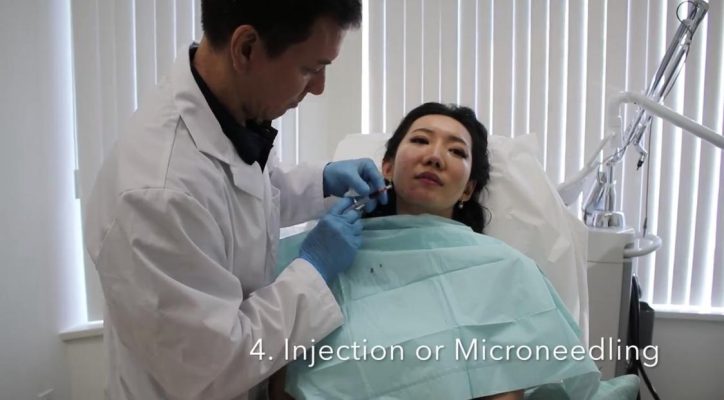The microneedling treatment lasts for 1 hour. The microneedle roller microneedling heads in 0.5 mm, 1.0 mm, and 1.5 mm options have a quick change function so you can easily switch between microneedle roller microneedling heads for a more efficient microneedling session.
The microneedling results will last through the years as microneedling stimulates your body to naturally create collagen and elastin, thus plumping up your skin. The microneedling treatment has the added benefit of creating a heightened absorption rate of any skincare or anti-aging products you use.
That is a very individualized treatment plan so we cannot estimate costs until we have taken a full history and completed a skin consultation to see what microneedling treatments will provide you with the best microneedling results.
A topical numbing cream is applied 90 minutes prior to microneedling. Many patients do not feel the microneedling treatment at all, while others will describe it as a microneedling sharp/stinging sensation that lasts for 15-20 seconds after microneedling.
Before microneedling, consider factors such as avoiding sun exposure, discontinuing certain skincare products, and informing your provider about any medical conditions or medications to ensure a safe and effective treatment.
Concerns with microneedling include the potential for skin irritation, infection, or adverse reactions, emphasizing the importance of proper technique, hygiene, and post-treatment care.
When microneedling, avoid sun exposure, picking at treated areas, using harsh skincare products, and engaging in strenuous physical activities immediately afterward to prevent irritation and optimize the healing process.
Before microneedling, expect a consultation discussing skincare routine adjustments; after the procedure, anticipate temporary redness, mild swelling, and gradual improvements in skin texture, tone, and collagen production over several weeks.
Microneedling can yield noticeable results after a single session, but a series of treatments, typically spaced 4-6 weeks apart, is often recommended for optimal and sustained improvements in skin texture and appearance.
The healing time after microneedling varies, but most individuals experience redness and mild swelling for 1 to 3 days, with complete skin recovery typically occurring within a week.
You can observe microneedling’s effectiveness by noting improvements in skin texture, reduced appearance of fine lines or scars, and enhanced overall skin radiance over the weeks following the procedure.
After microneedling, use a gentle cleanser, a soothing serum with ingredients like hyaluronic acid, and a post-treatment moisturizer to promote hydration and support the skin’s healing process.
Microneedling should be avoided in individuals with active acne or skin infections to prevent the spread of bacteria and potential exacerbation of the condition.
After microneedling, expect mild redness and swelling for a day or two, followed by improvements in skin texture, tone, and collagen production in the weeks following the procedure.
Common side effects of microneedling include temporary redness, mild swelling, and occasional pinpoint bleeding at the treatment site, with rare instances of bruising or infection.
After microneedling, avoid products containing harsh ingredients such as retinoids, benzoyl peroxide, or acids, and opt for gentle, hydrating skincare to prevent irritation and support the skin’s recovery.
After skin needling, avoid products with harsh or irritating ingredients such as retinoids, acids, and alcohol-based products, opting for gentle and hydrating formulations to promote optimal healing.
Visible results from microneedling can be seen within a few days to a week, but the full benefits, including improved skin texture and collagen production, become more apparent over several weeks to months with a series of treatments.
While some immediate skin improvement can be observed, the full results of microneedling, including enhanced skin texture and collagen production, typically become more noticeable in the days to weeks following the procedure.
Microneedling can contribute to skin tightening by stimulating collagen production, with noticeable improvements typically becoming more apparent over a few weeks to months as the collagen remodeling process takes effect.
To expedite healing after microneedling, stay well-hydrated, use a gentle post-treatment skincare routine, avoid sun exposure, and follow any additional recommendations from your skincare professional for optimal recovery.
Yes, you can wash your face after microneedling, but it’s advisable to use a gentle cleanser and avoid harsh products to prevent irritation during the initial healing period.
Yes, it is recommended to apply a broad-spectrum sunscreen after microneedling to protect the treated skin from harmful UV rays, aiding in the healing process and preventing potential pigmentation issues.
If you experience increasing redness, swelling, warmth, persistent pain, or notice discharge with an unusual color or odor, it may indicate infection after microneedling, and prompt medical attention is advised.
Microneedling is suitable for various skin types, but individuals with concerns like acne scars, fine lines, or uneven texture often benefit, while those with active infections or certain skin conditions should consult with a skincare professional.
Microneedling can be suitable for sensitive skin when performed with caution and using appropriate techniques, but individuals with sensitive skin should consult with a skincare professional to minimize the risk of irritation.
The effects of microneedling are long-lasting, with improvements in skin texture, tone, and collagen production often persisting for several months to a year, depending on individual factors and maintenance treatments.
It’s generally recommended to wait at least 24 hours after microneedling before taking a shower to allow the skin to recover and minimize the risk of irritation.
The frequency of skin needling treatments depends on individual skincare goals and the specific procedure, but common recommendations include sessions spaced 4 to 6 weeks apart for optimal and sustained results.
Microneedling is generally suitable for all skin types, but individuals with certain skin conditions or concerns should consult with a skincare professional to ensure the procedure is appropriate for their specific needs.
While some immediate improvements can be observed after one microneedling treatment, optimal and sustained results often require a series of sessions to achieve enhanced skin texture, tone, and collagen production.
It’s advisable to wait at least 24 hours after microneedling before applying makeup to allow the skin to recover and minimize the risk of irritation.
Microneedling can contribute to smoother skin by promoting collagen production and improving texture, with noticeable results typically becoming more apparent in the weeks following the procedure.
Using ice after microneedling can help reduce post-treatment redness and swelling, but it’s important to wrap the ice in a cloth and avoid direct contact with the skin to prevent irritation.
It’s advisable to avoid wearing a mask immediately after microneedling to minimize the risk of irritation and allow the skin to heal, especially if the mask fits tightly and may cause friction.
Yes, applying a gentle and hydrating moisturizer after microneedling is recommended to soothe the skin and support the healing process.
Redness after microneedling typically lasts for a day or two, but individual variations can occur, and using gentle skincare can help alleviate it.
Yes, you can drink coffee after microneedling, but it’s advisable to opt for decaffeinated or limit caffeine intake, as excessive consumption may contribute to skin dehydration.
Mild itching after microneedling is a common and temporary reaction as the skin heals, but persistent or severe itching may warrant consultation with a skincare professional.
To disinfect after microneedling, use a gentle, non-alcoholic antiseptic solution or a solution provided by your skincare professional, applying it with a clean cotton pad to minimize the risk of infection.
Clean the treated area after microneedling by using a mild, fragrance-free cleanser and lukewarm water, avoiding harsh products to prevent irritation during the initial healing period.
Microneedling is also known as collagen induction therapy.
A needle size ranging from 0.5 to 1.5 millimeters is typically considered best for microneedling on the face.
If microneedling is done incorrectly, it can lead to skin irritation, infections, scarring, or uneven skin texture.
Side effects of improperly performed microneedling can include skin redness, swelling, bruising, infections, scarring, and hyperpigmentation.
Microneedling does not have a direct impact on the immune system.
The number of microneedling treatments varies based on individual skin concerns, but typically, a series of 3 to 6 treatments spaced about 4 to 6 weeks apart is recommended for optimal results.
Individuals with active skin infections, certain autoimmune diseases, a history of keloid scars, or recent use of certain medications like isotretinoin may not be suitable candidates for microneedling.
Pregnant women, individuals with active skin infections, or those with certain skin conditions or medications contraindicating the procedure should not undergo microneedling.
Safety precautions for skin needling include ensuring sterile equipment, avoiding areas with active infections or lesions, and following proper post-procedure care to minimize risks.
After microneedling, it’s safe to use recommended post-care products such as gentle cleansers, hyaluronic acid serums, and broad-spectrum sunscreen to protect the treated skin.
Mistakes in microneedling can include using improper needle depth, failing to maintain sterility, over-treating areas, neglecting post-procedure care, or treating unsuitable skin conditions or types.
The microneedling procedure typically takes about 30 minutes to 1 hour, depending on the size of the treated area and specific concerns addressed.
Microneedling results are not permanent; regular maintenance treatments are typically recommended to sustain the benefits.
























 604-706-1503 (English)
604-706-1503 (English) 604-305-2098 (Chinese)
604-305-2098 (Chinese)
 604-305-2098 (English)
604-305-2098 (English) 604-305-2098 (Chinese)
604-305-2098 (Chinese)
 604-210-6319 (English)
604-210-6319 (English) 604-305-2098 (Chinese)
604-305-2098 (Chinese)
 604-265-7044 (English)
604-265-7044 (English) 604-305-2098 (Chinese)
604-305-2098 (Chinese)



